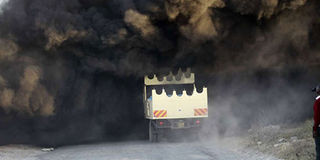Use ozone international day to create awareness on skin cancer

A truck drives through a cloud of smoke caused by the burning of tyres in Athi River on February 2, 2019. Such activities damage the ozone layer. PHOTO | FILE | NATION MEDIA GROUP
What you need to know:
- The WHO estimates that a 10 per cent decrease in ozone levels will result in an additional 300,000 non-melanoma skin cancer cases annually.
- To date, the parties to the Montreal Protocol have phased out 98 per cent of ODS globally compared to 1990.
On Monday, Kenya will join the rest of the world in marking the United Nations’ International Day for the Preservation of the Ozone Layer.
It goes without saying that a considerable number of those reading this article are tempted to think that this day is a preserve for a few people, especially experts in Space matters.
In order to appreciate the importance of this day, let me begin by shedding light on what the ozone layer, or ozone shield, is all about and why you should be concerned.
The ozone layer is a ‘blanket’ of gases in the atmosphere that shields us from harmful ultraviolet radiation from the sun.
It plays a vital role in absorbing harmful components of sunlight, known as ultraviolet rays (UV-B), which are associated with skin cancer, eye cataracts, reduced plant and animal productivity, poor air quality and disruption of marine ecosystems.
According to the World Health Organisation (WHO), two to three million cases of non-melanoma skin cancers occur every year.
HARMFUL GASES
Non-melanoma skin cancers are most frequent on parts of the body that are commonly exposed to the sun, such as ears, face, neck and forearms, WHO explains.
In the past few decades however, the ozone has been threatened by man-made gases released into the atmosphere. These harmful gases that eat away the ozone layer are known as chlorofluorocarbons (CFCs).
The CFC gases are used in various industries. For instance, halons are used in fire extinguishers and methyl bromide in the post-harvest grain sector.
Most refrigerants found in air conditioners, refrigerators and freezers contain CFCs. If you happened to buy a refrigerator in the 1980s, chances are that you contributed to the increasing cases of skin cancers.
The CFCs are non-toxic, non-flammable and very stable, which makes them ideal for use in appliances. However, it is their stability that creates environmental problems.
MONTREAL PROTOCOL
Chemical reactions involving chlorine and bromine cause the ozone in the southern polar region to be destroyed. This depleted region is what is commonly referred to as ‘ozone hole’.
But the good news is that the ozone hole is healing (reducing), thanks to the Montreal Protocol, which was finalised in 1987.
The Montreal Protocol is a global agreement to protect the ozone layer by phasing out the production and consumption of ozone-depleting substances (ODS). It was the first treaty to achieve universal ratification.
Kenya signed the Montreal Protocol in 1988 and has ratified it and its various amendments, the latest being the Kigali Amendment in 2016, where parties agreed to phase down production and consumption of hydrofluorocarbons (HFCs).
The HFCs, which are now widespread in air conditioners, refrigerators, aerosols, foams and other products, were introduced as non-ozone-depleting alternatives to support the timely phase-out of CFC.
HOPE
But it was later discovered that although HFCs do not deplete the ozone layer, they have global warming potential.
The HFCs are nearly 2,000 times more potent than carbon dioxide in terms of their global warming potential and uncontrolled growth in HFC emissions; therefore, challenge efforts to keep global temperature rise at or below 2° Celsius this century.
The WHO estimates that a 10 per cent decrease in ozone levels will result in an additional 300,000 non-melanoma skin cancer cases annually.
However, it is estimated that if the Montreal Protocol is fully implemented, the ozone layer will heal completely by the middle of this century. This means that skin cancers will reduce too.
To date, the parties to the protocol have phased out 98 per cent of ODS globally compared to 1990, according to UN Environment.
As we continue to push for the phasing out of the remaining two per cent of ODS, it is imperative that the commemorative day is used to create awareness about skin cancer among Kenyans.
FATALITIES
A report presented in Parliament recently by the National Cancer Institute of Kenya (NCI-K) indicated that at least 90 people die of cancer daily in the country. That means Kenya loses at least three people to cancer every hour.
Recent reports indicate that skin cancer prevalence is on the rise in Kenya, and therefore, we cannot afford the luxury of marking the ozone layer day without creating awareness about the disease.
Mr Onyango, a reporter with 'Taifa Leo' and 'Daily Nation', is a climate change adaptation Master's student at the University of Nairobi. [email protected]





